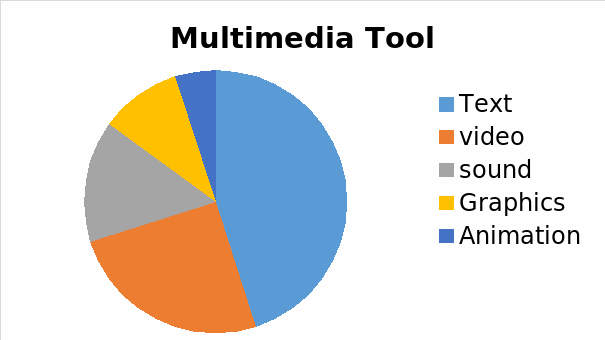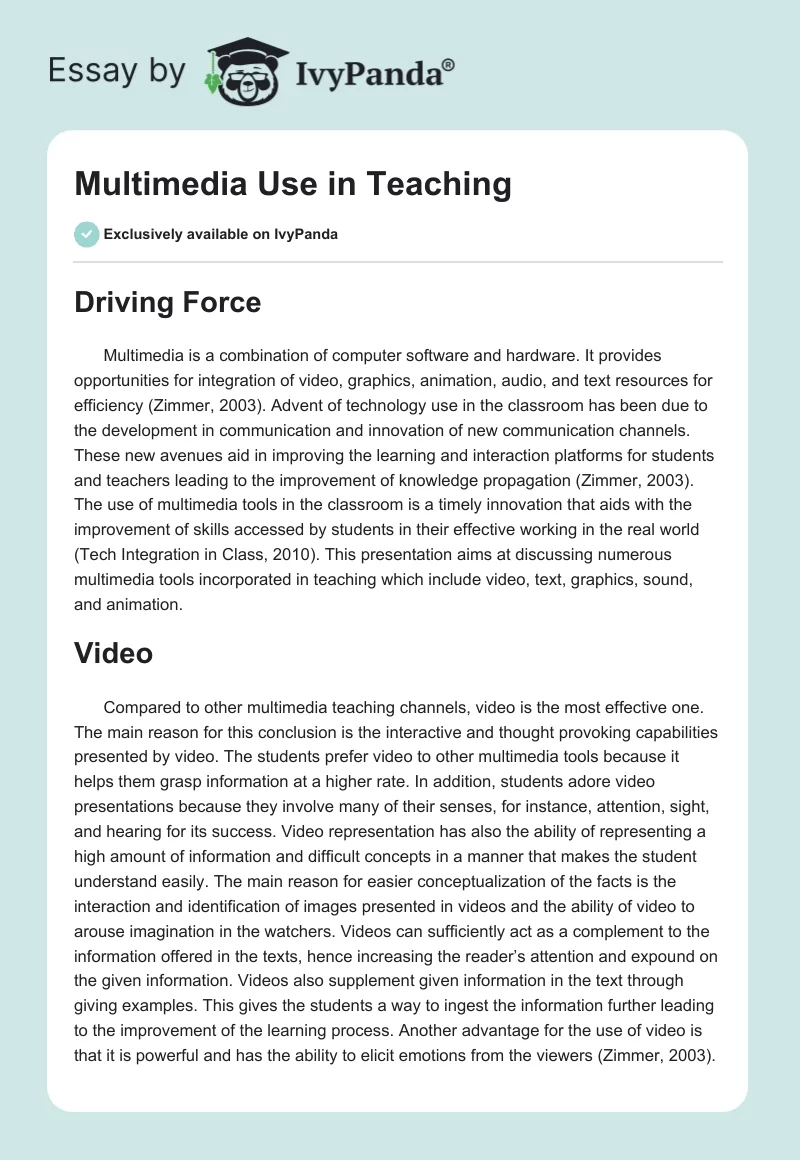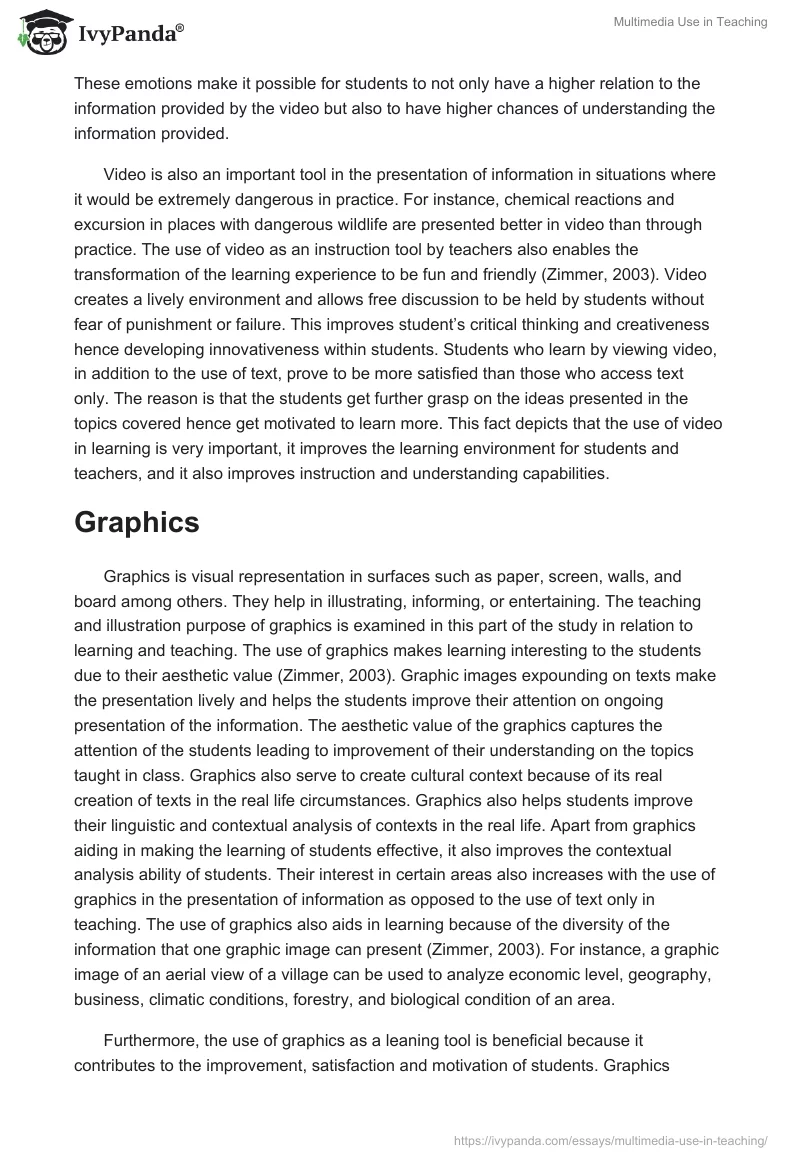Driving Force
Multimedia is a combination of computer software and hardware. It provides opportunities for integration of video, graphics, animation, audio, and text resources for efficiency (Zimmer, 2003). Advent of technology use in the classroom has been due to the development in communication and innovation of new communication channels. These new avenues aid in improving the learning and interaction platforms for students and teachers leading to the improvement of knowledge propagation (Zimmer, 2003). The use of multimedia tools in the classroom is a timely innovation that aids with the improvement of skills accessed by students in their effective working in the real world (Tech Integration in Class, 2010). This presentation aims at discussing numerous multimedia tools incorporated in teaching which include video, text, graphics, sound, and animation.
Video
Compared to other multimedia teaching channels, video is the most effective one. The main reason for this conclusion is the interactive and thought provoking capabilities presented by video. The students prefer video to other multimedia tools because it helps them grasp information at a higher rate. In addition, students adore video presentations because they involve many of their senses, for instance, attention, sight, and hearing for its success. Video representation has also the ability of representing a high amount of information and difficult concepts in a manner that makes the student understand easily. The main reason for easier conceptualization of the facts is the interaction and identification of images presented in videos and the ability of video to arouse imagination in the watchers. Videos can sufficiently act as a complement to the information offered in the texts, hence increasing the reader’s attention and expound on the given information. Videos also supplement given information in the text through giving examples. This gives the students a way to ingest the information further leading to the improvement of the learning process. Another advantage for the use of video is that it is powerful and has the ability to elicit emotions from the viewers (Zimmer, 2003). These emotions make it possible for students to not only have a higher relation to the information provided by the video but also to have higher chances of understanding the information provided.
Video is also an important tool in the presentation of information in situations where it would be extremely dangerous in practice. For instance, chemical reactions and excursion in places with dangerous wildlife are presented better in video than through practice. The use of video as an instruction tool by teachers also enables the transformation of the learning experience to be fun and friendly (Zimmer, 2003). Video creates a lively environment and allows free discussion to be held by students without fear of punishment or failure. This improves student’s critical thinking and creativeness hence developing innovativeness within students. Students who learn by viewing video, in addition to the use of text, prove to be more satisfied than those who access text only. The reason is that the students get further grasp on the ideas presented in the topics covered hence get motivated to learn more. This fact depicts that the use of video in learning is very important, it improves the learning environment for students and teachers, and it also improves instruction and understanding capabilities.
Graphics
Graphics is visual representation in surfaces such as paper, screen, walls, and board among others. They help in illustrating, informing, or entertaining. The teaching and illustration purpose of graphics is examined in this part of the study in relation to learning and teaching. The use of graphics makes learning interesting to the students due to their aesthetic value (Zimmer, 2003). Graphic images expounding on texts make the presentation lively and helps the students improve their attention on ongoing presentation of the information. The aesthetic value of the graphics captures the attention of the students leading to improvement of their understanding on the topics taught in class. Graphics also serve to create cultural context because of its real creation of texts in the real life circumstances. Graphics also helps students improve their linguistic and contextual analysis of contexts in the real life. Apart from graphics aiding in making the learning of students effective, it also improves the contextual analysis ability of students. Their interest in certain areas also increases with the use of graphics in the presentation of information as opposed to the use of text only in teaching. The use of graphics also aids in learning because of the diversity of the information that one graphic image can present (Zimmer, 2003). For instance, a graphic image of an aerial view of a village can be used to analyze economic level, geography, business, climatic conditions, forestry, and biological condition of an area.
Furthermore, the use of graphics as a leaning tool is beneficial because it contributes to the improvement, satisfaction and motivation of students. Graphics improves understanding of the concepts presented by the teachers in class than the use of text only (Tammy, 2011). This increased understanding improves the satisfaction of students with their learning experience and also motivates them to learn more in the subject dealt with in class (Graphic designs, 2012). Therefore, graphics helps with the improvement of dedication of students hence improvement in the understanding and learning as well as education as a whole. Graphics also aids in improving the memory ability of the students because it has aesthetic value, which is appealing to the students. This leads to a better position at the recollection of information presented in graphics and text than the information presented in the text format only. Graphics also elaborates complex concepts for easy understanding. (Zimmer, 2003). Graphical images have also the ability of stimulating visual imagination, which contributes to easy comprehension of complex items. So, graphics is a very important multimedia tool to be used in teaching (Osborne, 1999).
Sound
Sound is a multimedia tool that plays a very important role in relating the ideas presented through text clearly. Sound in the classroom grants students chances of learning at their own time because it provides chances of recording or copying information in compact disks, flash or memory cards for future retrieval. Playing of the information later allows learning process to continue beyond the classroom (Tammy, 2011). Incorporation of explanations to presented texts increases the rate of interaction and understanding. Through the sound, students gain the advantage of greater understanding. The reason for that is that it motivates their engrossment in the lessons (Zimmer, 2003). The other reason for the success of the sound creatively crafted and incorporated in text protection is its ability in motivating imagination. This motivation improves not only the understanding but also the teaching association in the classroom, hence making the use of multimedia in teaching a success. However, the success of the sound as a multimedia tool depends on the creativity of the learning tool. Sound that is well crafted fulfills the purpose effectively, while on the other hand, it can be a distraction. Therefore, students have the responsibility of ensuring the sound used in a multimedia presentation is perfect to avoid reducing the information presented. The other main advantage of the sound is the ability of the presenter to stop, pause, or replay using the sound device while the presentation continues (Zimmer, 2003). This gives the students chances to request for clarification or ask questions. This also allows students to access records of information for further use after the class. In addition, through sound media, the students can replay the information at their own time after the presentation was played. Future retrieval of sound information increases chances of the students’ understanding, hence effectiveness of teaching (Tammy, 2011). Sound, therefore, plays a crucial role in the dissemination of information.
Animation
Animation is the rapid sequence of images to create the illusion of movement. This can be used to depict different information. For long it has been utilized in movies but recently it is used in teaching (Tech Integration in Class, 2010).
Cognitive thinking and learning improves with the use of animation because of the interesting nature of animation (Tech Integration in Class, 2010). Understanding improves, with the enjoyment of a certain form of learning; hence animation improves the effectiveness of teaching. Student’s attention in the classroom is also improved with the use of animation as a teaching tool. The creation and maintenance of interest in class can be achieved with the use of animation. It also improves visual communication of the students when incorporated in teaching (Tech Integration in Class, 2010). Teaching by animation improves the ability of students in understanding and interpreting pictures, hence fits well in the multimedia world today. Creativity also improves with the incorporation of animation in teaching, therefore, incorporation of animation in teaching is essential. The satisfaction achieved by the students after the use of animations contributes significantly to the development of education. Animation helps in the development of storytelling skills in the learners due to the use of silhouette features and computer aided 2D and 3D pictures. Storytelling skills development on the learners is important for personal development of the students and creation of better understanding of concepts. Creativity and innovation in learners improved with the incorporation of animation in learning (Tech Integration in Class, 2010). Animation used together with other multimedia tools including text, sound and graphics has a positive effect on the innovativeness of the learners. The ability to critically think and analyze facts increases with the use of animation as the students try to analyze and understand concepts represented in animation.
Text
Text is the main multimedia channel applied in multimedia communication as a tool in information dissemination. Multimedia allows the presentation of test in a designed and creative manner to seize the attention of the reader. Text is the main way through which the information can be passed. It acts as a tool to make the other multimedia tools successful as teaching tools in the classroom. A combination of texts, video, and sound presents a very attractive channel to initiate learning. The students engage all senses and are more attentive leading to success of the use of multimedia information dissemination by teachers. Text helps with the presentation of procedures in a logical manner where the efficiency of other information tools is deficient. Information in the text format is very clear and assists in understanding of the information by students (Tammy, 2011), due to the incorporation of examples and illustrations within the texts. Therefore, text is an important multimedia tool in information dissemination in the classrooms and is indispensable in the search for efficient teaching.
Percentage Influence of multimedia tools on teaching

This chart is a representation of the percentage influence each of the multimedia tools has on teaching. The most influential multimedia tool is text, followed by sound. Video, graphics and animation also influence teaching in the respective order. It serves to give the credit given at the conclusion of this presentation that multimedia tools play an important part in the learning process.
Conclusion
In conclusion, a combined effect of the five main multimedia tools presented have influenced teaching positively. Multimedia tools have led to improved information dissemination and is a welcome innovativeness for both teachers and students.
References
Osborne, H. (1999). In Other Words…Teaching with Pictures. Web.
Tammy A. (2011). Pros and Cons of Using Multimedia in the Classroom. Web.
Tech Integration in Class. (2010). The Use of Animation as a Teaching and Learning Tool to Engage Students’ Interest in the Classroom.
Zimmer, J. (2003). “Teaching Effectively with Multimedia,” Visionlearning Vol. 9. Web.


